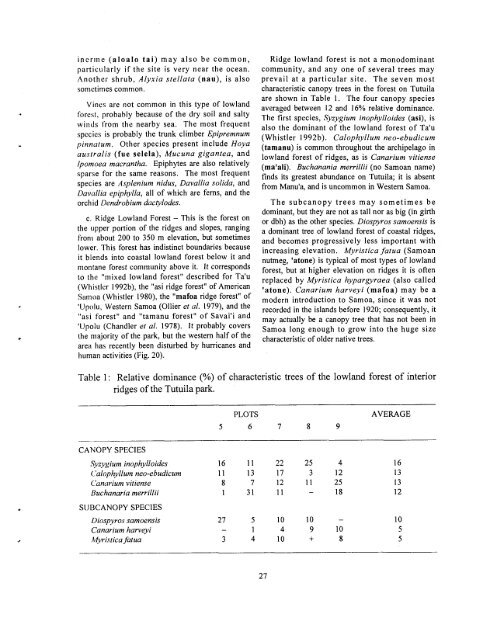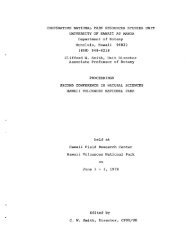american samoa - University of Hawaii at Manoa
american samoa - University of Hawaii at Manoa
american samoa - University of Hawaii at Manoa
Create successful ePaper yourself
Turn your PDF publications into a flip-book with our unique Google optimized e-Paper software.
incrme (aloalo tai) may also be common,<br />
particularly if the site is very near the ocean.<br />
Another shrub, Alyxia stell<strong>at</strong>a (nau), is also<br />
sometimes common.<br />
Vines are not common in this type <strong>of</strong> lowland<br />
forest, probably because <strong>of</strong> the dry soil and salty<br />
winds from the nearby sea. The most frequent<br />
species is probably the trunk climber Epipremnum<br />
pinn<strong>at</strong>um. Other species present include Hoya<br />
australis (fue selela), Mucuna gigantea, and<br />
Ipomoea macrantha. Epiphytes are also rel<strong>at</strong>ively<br />
sparse for the same reasons. The most frequent<br />
species are Asplenium nidus, Davallia solida, and<br />
Davallia epiphylla, all <strong>of</strong> which are ferns, and the<br />
orchid Dendrobium dactylodes.<br />
c. Ridge Lowland Forest - This is the forest on<br />
the upper portion <strong>of</strong> the ridges and slopes, ranging<br />
from about 200 to 350 m elev<strong>at</strong>ion, but sometimes<br />
lower. This forest has indistinct boundaries because<br />
it blends into coastal lowland forest below it and<br />
montane forest community above it. It corresponds<br />
to the "mixed lowland forest" described for Ta'u<br />
(Whistler 1992b), the "asi ridge forest" <strong>of</strong> American<br />
Samoa (Whistler 1980), the "mafoa ridge forest" <strong>of</strong><br />
'Upolu, Western Samoa (Ollier et al. 1979), and the<br />
"asi forest" and "tamanu forest" <strong>of</strong> Savai'i and<br />
'Upolu (Chandler et a[. 1978). It probably covers<br />
the majority <strong>of</strong> the park, but the western half <strong>of</strong> the<br />
area has recently been disturbed by hurricanes and<br />
human activities (Fig. 20).<br />
Ridge lowland forest is not a monodominant<br />
community, and any one <strong>of</strong> several trees may<br />
prevail <strong>at</strong> a particular site. The seven most<br />
characteristic canopy trees in the forest on Tutuila<br />
are shown in Table 1. The four canopy species<br />
averaged between 12 and 16% rel<strong>at</strong>ive dominance.<br />
The first species, Syzygium inophylloides (asi), is<br />
also the dominant <strong>of</strong> the lowland forest <strong>of</strong> Ta'u<br />
(Whistler 1992b). Calophyllum neo-ebudicum<br />
(tamanu) is common throughout the archipelago in<br />
lowland forest <strong>of</strong> ridges, as is Canarium vitiense<br />
(ma'ali). Buchanania merrillii (no Samoan name)<br />
finds its gre<strong>at</strong>est abundance on Tutuila; it is absent<br />
from Manu'a, and is uncommon in Western Samoa.<br />
The subcanopy trees may sometimes be<br />
dominant, but they are not as tall nor as big (in girth<br />
or dbh) as the other species. Diospyros samoensis is<br />
a dominant tree <strong>of</strong> lowland forest <strong>of</strong> coastal ridges,<br />
and becomes progressively less important with<br />
increasing elev<strong>at</strong>ion. Myristica f<strong>at</strong>ua (Samoan<br />
nutmeg, '<strong>at</strong>one) is typical <strong>of</strong> most types <strong>of</strong> lowland<br />
forest, but <strong>at</strong> higher elev<strong>at</strong>ion on ridges it is <strong>of</strong>ten<br />
replaced by Myristica hypargyraea (also called<br />
'<strong>at</strong>one). Canarium harveyi (mafoa) may be a<br />
modern introduction to Samoa, since it was not<br />
recorded in the islands before 1920; consequently, it<br />
may actually be a canopy tree th<strong>at</strong> has not been in<br />
Samoa long enough to grow into the huge size<br />
characteristic <strong>of</strong> older n<strong>at</strong>ive trees.<br />
Table 1: Rel<strong>at</strong>ive dominance (%) <strong>of</strong> characteristic trees <strong>of</strong> the lowIand forest <strong>of</strong> interior<br />
ridges <strong>of</strong> the Tutuila park.<br />
CANOPY SPECIES<br />
PLOTS AVERAGE<br />
5 6 7 8 9<br />
Syzygium inophy No ides 16 11 22 25 4 16<br />
Calophyllum neo-ebudicum 11 13 17 3 12 13<br />
Canarium vitiense 8 7 12 11 2 5 13<br />
Buchanaria merrillii 1 3 1 11 - 18 12<br />
SlJBCANOPY SPECIES<br />
Diospyros samoensis<br />
Canarium harveyi<br />
Myristica f<strong>at</strong>ua
















